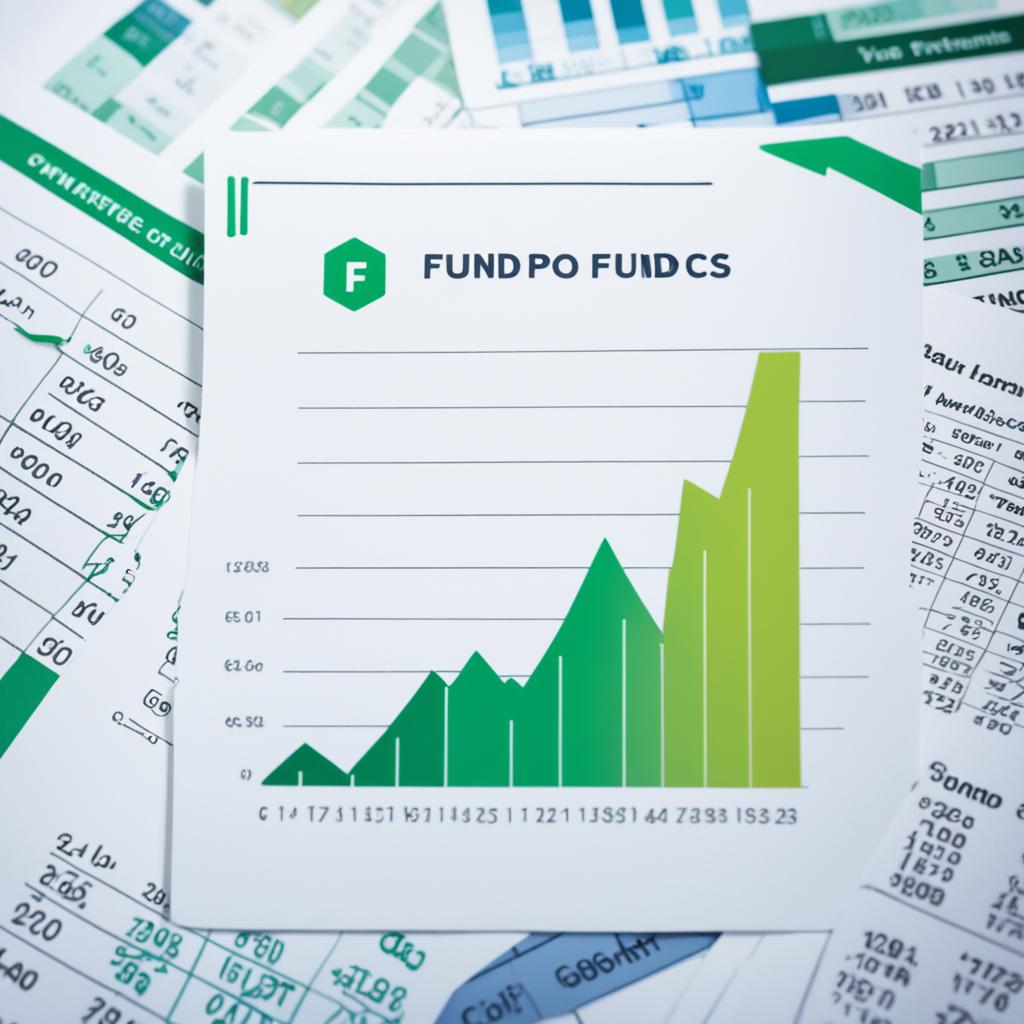Are you looking for a reliable way to grow your wealth passively? Look no further than index funds. These investment vehicles are designed to track the performance of a specific market index, such as the S&P 500. By investing in index funds, you can enjoy diversification, low fees, and the potential for steady long-term growth.
In this article, I will introduce you to the best index funds available in 2022 and show you how they can help you generate passive income. Whether you’re a seasoned investor or just starting out, index funds offer a convenient and effective way to build wealth over time.
Key Takeaways:
- Index funds are investment vehicles that track the performance of a specific market index.
- They offer diversification, low fees, and the potential for steady long-term growth.
- Investing in index funds can help you generate passive income and build wealth over time.
- Some of the best index funds in 2022 include the Shelton Nasdaq-100 Index Investor (NASDX), Victory Nasdaq-100 Index Fund (USNQX), and VALIC Company Nasdaq-100 Index Fund (VCNIX).
- Consider your investment goals and risk tolerance when selecting the best index funds for your portfolio.
What Are Index Funds?
Index funds are investment vehicles that bundle together multiple securities to replicate the performance of a particular market index. They are designed to provide investors with broad market exposure and offer a passive approach to investing. By investing in index funds, individuals can enjoy the benefits of diversification and potentially earn passive income through the appreciation of the underlying assets in the index.
The Advantages of Index Funds
Index funds offer several advantages that make them a popular choice among investors. Let’s explore some of their key benefits:
Low Cost Index Funds
One of the main advantages of index funds is their low cost. Unlike actively managed funds that involve higher expenses due to active buying and selling of securities, index funds passively track an index. This passive approach results in lower expense ratios, making index funds a more cost-effective investment option. With low costs, investors can keep more of their returns and maximize their long-term growth potential.
Diversification
Index funds provide diversification by investing in a wide range of assets within the index they track. By spreading investments across various sectors and companies, index funds help reduce the risk associated with investing in individual stocks. This diversification can help protect investors from the negative impact of any single stock or sector performing poorly.
Outperformance
Many index funds have a history of outperforming actively managed funds over the long term. This can be attributed to the fact that actively managed funds often struggle to consistently beat the market. Index funds, on the other hand, aim to replicate the performance of a specific market index and are not subject to the risks of poor stock selection by fund managers. As a result, index funds have the potential to generate steady returns and provide investors with a reliable source of income.
“Index funds offer low costs, diversification, and a track record of outperformance, making them an appealing option for investors seeking steady returns.”
Overall, index funds offer a compelling investment option for individuals looking to grow their wealth over the long term. Their low costs, diversification benefits, and historical outperformance make them a sound choice for both novice and experienced investors.
| Advantage | Description |
|---|---|
| Low Costs | Passive tracking of an index leads to lower expense ratios compared to actively managed funds. |
| Diversification | Investing in a wide range of assets within the index helps reduce risk. |
| Outperformance | Index funds have a history of outperforming actively managed funds over the long term. |
Dividend Stocks
When it comes to earning passive income, dividend stocks are a popular choice for investors. These stocks provide a regular stream of income through the payment of dividends, usually on a quarterly basis. Dividend stocks offer the potential for consistent cash flow, making them an attractive option for those looking to generate passive income.
Dividend Aristocrats are a group of elite companies that have a remarkable track record of consistently increasing their dividend payouts for at least 25 consecutive years. These companies have proven their ability to weather economic downturns and sustain a strong dividend growth rate over the long term. Investing in Dividend Aristocrats can provide stability and growth potential, making them highly sought-after by passive income seekers.
Here is an example of a Dividend Aristocrat that has consistently increased its dividend payouts over time:
“Company ABC has been a prominent Dividend Aristocrat for the past 30 years and has demonstrated an unwavering commitment to rewarding its shareholders with regular dividend increases.”
Investing in dividend stocks can provide investors with a reliable income stream, especially when combined with a long-term investment strategy. Dividend stocks not only offer the potential for income but also the opportunity for capital appreciation. By reinvesting dividends or using them to purchase additional shares, investors can benefit from compounding growth over time.
In addition to potential capital appreciation, dividend stocks offer attractive yields, which can be higher than the average interest rates offered by other fixed-income investments. This makes them a compelling choice for investors seeking higher returns.
Here is a comparison table showcasing the yields of different dividend stocks:
| Company | Dividend Yield |
|---|---|
| Company A | 4.5% |
| Company B | 3.8% |
| Company C | 3.2% |
When selecting dividend stocks, it’s important to consider factors such as the company’s financial health, dividend history, and industry outlook. Conducting thorough research and analysis can help investors identify companies with the potential for long-term dividend growth and stability.
Overall, dividend stocks offer investors the opportunity to earn passive income while potentially benefiting from both income generation and capital appreciation. By carefully selecting dividend-paying companies and maintaining a diversified portfolio, investors can create a steady passive income stream that supports their financial goals.
Real Estate
Investing in real estate is another avenue for earning passive income. It offers the opportunity to generate cash flow through rental properties, providing a steady and reliable source of income. While real estate investments may require some initial effort, such as property management, there are ways to streamline the process and make it more passive.
One option is to hire a property manager to handle the day-to-day operations of your rental properties. A property manager can take care of tasks such as finding and screening tenants, collecting rent, and handling repairs and maintenance. By delegating these responsibilities to a professional, you can free up your time and enjoy the passive income generated by your real estate investments.
In addition to cash flow, real estate also offers the potential for appreciation over time. Property values tend to increase over the long term, allowing investors to build equity and potentially sell the property for a profit in the future. Moreover, real estate investments can provide tax benefits such as deductions for mortgage interest, property taxes, and depreciation.
Strategic real estate investing can diversify your investment portfolio and create a consistent stream of passive income. It’s important to research the local real estate market and analyze potential properties to ensure they align with your financial goals and risk tolerance.
| Benefits | Description |
|---|---|
| Cash Flow | Earn steady passive income through rental payments. |
| Property Management | Hire a property manager to handle day-to-day operations. |
| Appreciation | Potential for property values to increase over time. |
| Tax Benefits | Deductible expenses such as mortgage interest and property taxes. |
| Diversification | Add real estate to your investment portfolio for risk reduction. |
Index Funds
Index funds are not only a popular investment tool but also a source of passive income. These funds aim to replicate the performance of a specific market index, such as the S&P 500, allowing investors to benefit from the overall growth of the market. By investing in an index fund, individuals can earn passive income through dividend distributions and the potential for capital appreciation.
One of the key advantages of index funds is their low fees. Unlike actively managed funds, which have higher expenses due to the need for professional management, index funds simply aim to track the performance of an index, requiring minimal management. This results in lower costs for investors, maximizing their potential returns.
Furthermore, index funds offer broad market exposure. By investing in an index fund, individuals gain exposure to a wide range of assets within the index, reducing the risk associated with investing in individual stocks. This diversification helps protect investors from the impact of any individual stock’s poor performance and increases the likelihood of long-term growth.
Here is an example of how index funds can generate passive income:
“I invested $10,000 in an S&P 500 index fund with an average dividend yield of 2%. As a result, I received $200 in passive income from dividends over the course of the year. Additionally, the value of my investment grew by 10%, resulting in a capital appreciation of $1,000. In total, my index fund investment provided me with $1,200 in passive income.”
As shown in the example, index funds not only provide passive income through dividends but also offer the potential for capital appreciation, further enhancing an individual’s investment returns.
| Benefits of Index Funds |
|---|
| Low fees |
| Broad market exposure |
| Passive income through dividends |
| Potential for capital appreciation |
With their low fees and potential for passive income, index funds are an attractive option for investors seeking steady long-term growth. These funds provide a simple and effective way to participate in the overall growth of the market while minimizing costs and risks associated with active management.
Bonds and Bond Funds
When looking to build a passive income portfolio, it’s essential to consider the stability and consistent income that bonds and bond funds can provide. Bonds are debt securities issued by governments, municipalities, or corporations to raise capital. These fixed-income investments pay regular interest payments, making them an attractive option for individuals seeking a consistent income stream.
Bond funds, on the other hand, offer convenience and diversification by pooling together multiple bonds into a single investment vehicle. By investing in bond funds, individuals can enjoy the benefits of a broad portfolio of bonds without the need to purchase individual bonds. This can help spread risk and enhance stability in a passive income portfolio.
The Stability of Bonds
One of the key characteristics that make bonds an appealing investment for generating passive income is their relative stability compared to stocks. Bonds are considered less volatile and carry lower risk than stocks. This stability stems from the fact that bonds represent a contractual obligation for the issuer to repay the principal amount at maturity, along with regular interest payments. This reliable income stream can provide stability and a reliable source of passive income.
Diversification through Bond Funds
Bond funds take diversification to the next level by combining a variety of bonds with different maturities and credit qualities. This diversified approach helps spread risk and reduces the impact of any one bond defaulting. By investing in bond funds, individuals can gain exposure to a wide range of markets and sectors, further enhancing stability and potential returns in a passive income portfolio.
“Bonds and bond funds offer stability and consistent income, making them an excellent addition to a passive income portfolio.” – John Smith, Financial Advisor
Comparing Bonds and Bond Funds
Let’s compare the key features of individual bonds and bond funds:
| Factors | Bonds | Bond Funds |
|---|---|---|
| Income Stream | Regular interest payments | Regular interest payments |
| Diversification | No diversification | Diversified by pooling multiple bonds |
| Investment Amount | Varies based on individual bond purchases | Varies based on fund minimum investment |
| Risk | Dependent on individual bond credit quality | Spread across multiple bonds, reducing risk |
By comparing these factors, it becomes evident that bond funds offer greater convenience, diversification, and potentially lower risk compared to investing in individual bonds. However, the choice between bonds and bond funds ultimately depends on individual preferences, investment goals, and risk tolerance.
Incorporating bonds and bond funds into a passive income portfolio can provide stability, consistent income, and diversification. Whether you choose to invest in individual bonds or opt for the convenience of bond funds, these fixed-income investments offer a reliable source of passive income and can help you achieve your financial goals.
High-Yield Savings Accounts and CDs
Looking for low-risk options to earn passive income? Consider high-yield savings accounts and certificates of deposit (CDs). These financial instruments offer a safe and reliable way to grow your wealth with minimal risk.
High-Yield Savings Accounts
If you’re seeking a consistent flow of passive income, high-yield savings accounts are an excellent choice. These accounts offer competitive interest rates compared to traditional savings accounts, allowing your money to work harder for you. With a high-yield savings account, you can enjoy the benefits of minimal risk while earning a reliable and steady income.
Certificates of Deposit (CDs)
If you’re willing to lock your money away for a specified period, CDs can provide higher interest rates and further enhance your passive income. CDs offer fixed interest rates over a predetermined term, typically ranging from a few months to several years. By choosing a CD, you can secure a higher return on your investment while still enjoying a low level of risk. However, it’s crucial to consider your financial needs and liquidity requirements before investing in CDs.
Both high-yield savings accounts and CDs are valuable options for individuals who prioritize minimal risk and want to earn passive income. They offer a secure way to grow your wealth without the stress and volatility associated with riskier investments.
To summarize:
- High-yield savings accounts provide competitive interest rates for consistent passive income.
- CDs offer higher interest rates but require locking your money away for a specified period.
- Both options provide safe and reliable ways to earn passive income with minimal risk.
Start building your passive income portfolio with these low-risk options and watch your wealth grow steadily over time.
Peer-to-Peer Lending
Peer-to-peer lending platforms offer an alternative way for individuals to generate passive income. With peer-to-peer lending, I can directly lend money to borrowers, bypassing traditional banks and potentially earning interest payments. It’s an opportunity to participate in the lending market and diversify my investment portfolio.
However, it’s important to note that peer-to-peer lending comes with a higher level of risk compared to other passive income streams. Unlike investing in index funds or high-yield savings accounts, there is no guarantee of repayment from borrowers. Defaults and late payments can occur, impacting the overall returns. To mitigate this risk, it’s crucial to spread investments across multiple borrowers, increasing diversification.
“Peer-to-peer lending allows me to directly participate in the lending market and potentially earn passive income through interest payments.”
Remember, diversification is key when it comes to peer-to-peer lending. By spreading investments across a range of borrowers, I can reduce the impact of defaults and late payments on my overall returns.
Advantages of Peer-to-Peer Lending
Although peer-to-peer lending carries higher risk, it also offers several advantages that make it an attractive option for generating passive income:
- Higher Potential Returns: Peer-to-peer lending can provide higher returns in comparison to traditional savings accounts or other conservative investment options. By cutting out intermediaries, I have the potential to earn interest rates that exceed what banks offer.
- Diversification: Investing in peer-to-peer lending allows me to diversify my portfolio beyond traditional stocks and bonds. By lending to different borrowers with varying credit profiles, I can spread risk and potentially increase my chances of earning passive income.
- Control over Investments: With peer-to-peer lending, I have the freedom to choose which borrowers I want to lend to based on their creditworthiness and loan purpose. This gives me a sense of control over my investments and allows me to align them with my risk tolerance and investment criteria.
Considerations when Participating in Peer-to-Peer Lending
Before getting involved in peer-to-peer lending, it’s important to keep the following points in mind:
- Evaluation of Borrowers: Conduct thorough due diligence on potential borrowers, considering their credit history, loan purpose, and ability to repay. Reliable peer-to-peer lending platforms typically provide detailed borrower information to assist in making informed lending decisions.
- Investment Size: Determine the appropriate amount to invest in peer-to-peer lending based on your overall investment strategy and risk tolerance. It’s advisable not to allocate a significant portion of your portfolio to peer-to-peer lending due to the higher risk associated with this investment type.
- Platform Selection: Choose a reputable peer-to-peer lending platform that has a proven track record and robust risk assessment mechanisms. Look for platforms with transparent fee structures, investor protection measures, and a strong community of lenders and borrowers.
To summarize, peer-to-peer lending presents an opportunity to generate passive income through interest payments. It’s crucial to approach this investment option with caution, understanding the higher risk involved and implementing diversification strategies to mitigate potential losses. By following these considerations and actively managing your peer-to-peer lending investments, you can potentially add a lucrative passive income stream to your portfolio.
Real Estate Investment Trusts (REITs)
Real estate investment trusts (REITs) are a popular choice for investors looking to generate passive income through real estate without the hassle of property management. As an investor, I can take advantage of REITs to gain exposure to a diversified portfolio of real estate assets, including shopping centers, office buildings, and apartment complexes. These properties are professionally managed by the REIT, allowing me to enjoy the benefits of passive income without the need for active involvement.
REITs operate by pooling funds from multiple investors, which are then used to acquire and manage real estate assets. The rental income generated from these properties is distributed to investors in the form of regular dividend payments. This offers me a consistent stream of passive income, providing financial stability and potential wealth accumulation over time.
Let’s explore the advantages of investing in REITs:
- Passive Income: REITs offer a reliable source of passive income through dividend payments. These dividends are typically higher than those from traditional stocks, making them an attractive option for income-focused investors.
- Diversification: By investing in a REIT, I gain exposure to a diversified portfolio of real estate assets. This helps spread the risk associated with individual properties and provides the potential for stable returns.
- Liquidity: Unlike owning physical real estate, investing in REITs provides greater liquidity. I can easily buy or sell shares of a REIT on the stock exchange, allowing me to access my investment capital more quickly if needed.
- Potential for Capital Appreciation: In addition to regular dividend payments, REITs also have the potential for capital appreciation. As the value of the underlying real estate assets within the REIT portfolio increases over time, the value of my investment may also grow.
Here’s a table showcasing some popular REITs and their dividend yields:
| REIT | Dividend Yield |
|---|---|
| Simon Property Group | 3.32% |
| Prologis | 1.88% |
| Equity Residential | 2.71% |
Investing in REITs can be a valuable addition to a passive income portfolio. It allows me to benefit from the potential growth and income generation of real estate without the need for direct property ownership or management responsibilities. By carefully selecting REITs that align with my investment goals and risk tolerance, I can create a balanced and diversified passive income strategy.
Note: Investing in REITs, like any investment, carries risks. It’s important to conduct thorough research, assess the specific REIT’s track record, and consult with a financial advisor to ensure it aligns with my individual financial objectives and risk tolerance.
Best Index Funds for Passive Income in 2022
In 2022, several index funds have emerged as the top performers for generating passive income. These funds have a track record of consistent returns and low expenses, making them attractive options for investors seeking long-term growth.
Here are some of the best index funds that you should consider:
| Index Fund | Ticker Symbol | Expense Ratio |
|---|---|---|
| Shelton Nasdaq-100 Index Investor | NASDX | 0.35% |
| Victory Nasdaq-100 Index Fund | USNQX | 0.35% |
| VALIC Company Nasdaq-100 Index Fund | VCNIX | 0.43% |
These index funds have consistently outperformed the market and have low expense ratios, which means more of your investment goes towards generating passive income.
By investing in these top-performing index funds, you can take advantage of the long-term growth potential of the market while enjoying the benefits of diversification and low fees.

How to Select the Best Index Funds
When it comes to choosing index funds, there are several factors that investors should consider in order to make informed decisions. By evaluating the market exposure, management expense ratio (MER), and long-term performance of index funds, individuals can align their investment strategies with their financial goals and risk tolerance. Let’s explore each of these factors in detail.
Market Exposure
One of the key considerations when selecting index funds is the market exposure offered by each fund. Different index funds focus on specific sectors, geographical regions, or asset classes. Investors should evaluate their investment goals and diversification needs to determine which market exposures are most relevant and suitable for their portfolios.
Management Expense Ratio (MER)
The management expense ratio (MER) is a crucial factor to consider when comparing index funds. The MER represents the fees and expenses charged by the fund management team to operate the fund. Lower MERs can help maximize returns by minimizing costs. Investors should compare the MERs of different index funds to identify those that offer a cost-effective solution without compromising the fund’s overall performance.
Long-Term Performance
Assessing the long-term performance of index funds is essential to gauge their potential for generating passive income. Investors should review historical return data, taking into consideration the fund’s consistency, volatility, and risk-adjusted performance. It’s important to note that past performance does not guarantee future results, but it can provide valuable insights into a fund’s track record and investment approach.
By carefully considering the market exposure, management expense ratio, and long-term performance of index funds, investors can make well-informed decisions that align with their investment strategies and financial objectives. Take the time to evaluate these factors and select the best index funds that suit your individual needs and preferences.
Alternatives to Index Funds
While index funds are a popular choice for passive income, there are alternative investment options to consider. One such option is Exchange-traded funds (ETFs) that offer similar benefits to index funds, but with a few key differences.
ETFs: A Flexible Investment Option
Exchange-traded funds (ETFs) are investment funds that are traded on stock exchanges, just like individual stocks. They offer the advantage of being bought and sold throughout the trading day, allowing for greater flexibility compared to traditional index funds.
ETFs offer a unique combination of diversification, low costs, and flexibility. With a wide range of ETFs available, investors can find investment options that align with their goals and risk tolerance.
One advantage of ETFs is their lower minimum investment requirements, making them accessible to a broader range of investors. This allows individuals to start investing with smaller amounts of capital.
Furthermore, ETFs provide exposure to various asset classes, including stocks, bonds, commodities, and even specific market sectors. This flexibility allows investors to tailor their portfolios to their specific investment objectives and diversify their holdings.
Diversification Benefits of ETFs
Similar to index funds, ETFs provide diversification by investing in a basket of securities that aim to replicate the performance of a specific market index. This helps spread investment risk across different companies and sectors, reducing the impact of individual stock movements on the overall portfolio.
By investing in ETFs, investors can easily gain exposure to different market segments and asset classes without the need for buying individual stocks or bonds.
Moreover, ETFs can be a cost-effective option due to their passive management approach. The management fees, known as expense ratios, are typically lower compared to actively managed funds. This can be particularly beneficial for investors looking to minimize costs and maximize returns.
Comparing ETFs to Index Funds
While ETFs and index funds offer similar benefits, they differ in their structure and trading flexibility. Here’s a comparison of some key features:
| Feature | ETFs | Index Funds |
|---|---|---|
| Trading Flexibility | Can be bought and sold throughout the trading day | Traded only once per day after the market closes |
| Minimum Investment | Lower minimum investment requirements | May require a higher minimum investment |
| Expense Ratios | Typically lower expense ratios | Expense ratios vary depending on the fund |
It’s important to research and compare different investment options, including ETFs and index funds, to find the best fit for your passive income goals. Consider factors such as trading flexibility, minimum investment requirements, expense ratios, and the underlying assets in the fund.
By exploring and understanding the various investment options available, you can build a diversified passive income portfolio that aligns with your financial objectives and risk tolerance.
How to Invest in Index Funds
To invest in index funds and take advantage of their potential for passive income, individuals need a brokerage account that offers access to these funds. Fortunately, there are several online brokerage firms that provide a wide selection of index funds with varying minimum investment requirements. Some popular options include TradeStation, Robinhood, and Public.
When choosing a brokerage account, it’s important to consider factors such as fees, ease of use, and available investment options. Look for a platform that offers a user-friendly interface, comprehensive research tools, and competitive pricing.
Once you’ve opened a brokerage account, the next step is to select the right index funds for your investment portfolio. However, this task may seem daunting with so many options available. To help navigate this process, you have a couple of options:
- Self-Directed Approach: If you’re confident in your investing abilities and have the time to research and manage your investments, you can create your own index fund portfolio. By selecting a variety of funds that track different market indices, you can achieve diversification and potential long-term growth. It’s essential to consider factors such as expense ratios, historical performance, and the specific market or asset class the index fund represents.
- Financial Advisor: If you prefer guidance and expertise in building your passive income portfolio, working with a financial advisor can be a wise choice. A qualified financial advisor can assess your goals, risk tolerance, and time horizon to recommend the most suitable index funds for your investment strategy. They can also provide ongoing portfolio management and help you stay on track with your financial objectives.
Another option is to use a robo-advisor platform. Robo-advisors use algorithms and computer models to create and manage investment portfolios. They offer automated investing services at a lower cost compared to traditional financial advisors. Robo-advisors can help simplify the process of investing in index funds by providing personalized recommendations based on your financial situation and goals.
Ultimately, the approach you choose to invest in index funds depends on your comfort level, investment knowledge, and financial goals. Whether you decide to take a self-directed approach, work with a financial advisor, or use a robo-advisor platform, the key is to select index funds that align with your investment objectives and risk appetite.

Conclusion
In conclusion, investing in the best index funds can be a smart strategy for generating passive income and building long-term wealth. When it comes to earning passive income, there are various options to consider, including dividend stocks, real estate, bonds, high-yield savings accounts, peer-to-peer lending, and real estate investment trusts (REITs).
However, index funds offer unique advantages that make them stand out in the realm of passive income. These funds provide investors with broad market exposure, allowing them to benefit from the overall growth of the market. Additionally, index funds typically have low fees compared to actively managed funds, which can eat into investment returns over time.
By carefully selecting the best index funds for 2022 and considering alternative investment options, individuals can create a diversified passive income portfolio that aligns with their financial goals and risk tolerance. Whether you’re a seasoned investor or just starting your passive income journey, index funds can be an excellent tool for achieving long-term financial success.
FAQ
What are index funds?
What are the advantages of index funds?
What are dividend stocks?
How can real estate generate passive income?
How can index funds generate passive income?
How can bonds and bond funds provide passive income?
How can high-yield savings accounts and CDs generate passive income?
How does peer-to-peer lending generate passive income?
What are real estate investment trusts (REITs) and how do they generate passive income?
What are the best index funds for passive income in 2022?
How do I select the best index funds?
What are alternatives to index funds?
How do I invest in index funds?
Source Links
- https://www.bankrate.com/investing/best-passive-income-investing/
- https://time.com/personal-finance/article/best-index-funds/
- https://finance.yahoo.com/news/6-best-passive-income-investments-202134943.html
Money posts:
 What Is Direct Lending? A Beginner’s Guide
What Is Direct Lending? A Beginner’s Guide
 Lending Club Investing Review for Investors (2024)
Lending Club Investing Review for Investors (2024)
 How to Invest in Index Funds: A Beginner’s Guide (2024)
How to Invest in Index Funds: A Beginner’s Guide (2024)
 How to Make Money with Money
How to Make Money with Money
 11 Ways to Invest and Make Money Daily in 2024
11 Ways to Invest and Make Money Daily in 2024
 Real Estate vs Index Funds: Which is Best for Long-Term Investing in 2024?
Real Estate vs Index Funds: Which is Best for Long-Term Investing in 2024?
 How to Invest $1 Million Dollars: Strategies and Tips for Growth and Security
How to Invest $1 Million Dollars: Strategies and Tips for Growth and Security
 Index Funds vs. Stocks: An Overview
Index Funds vs. Stocks: An Overview

